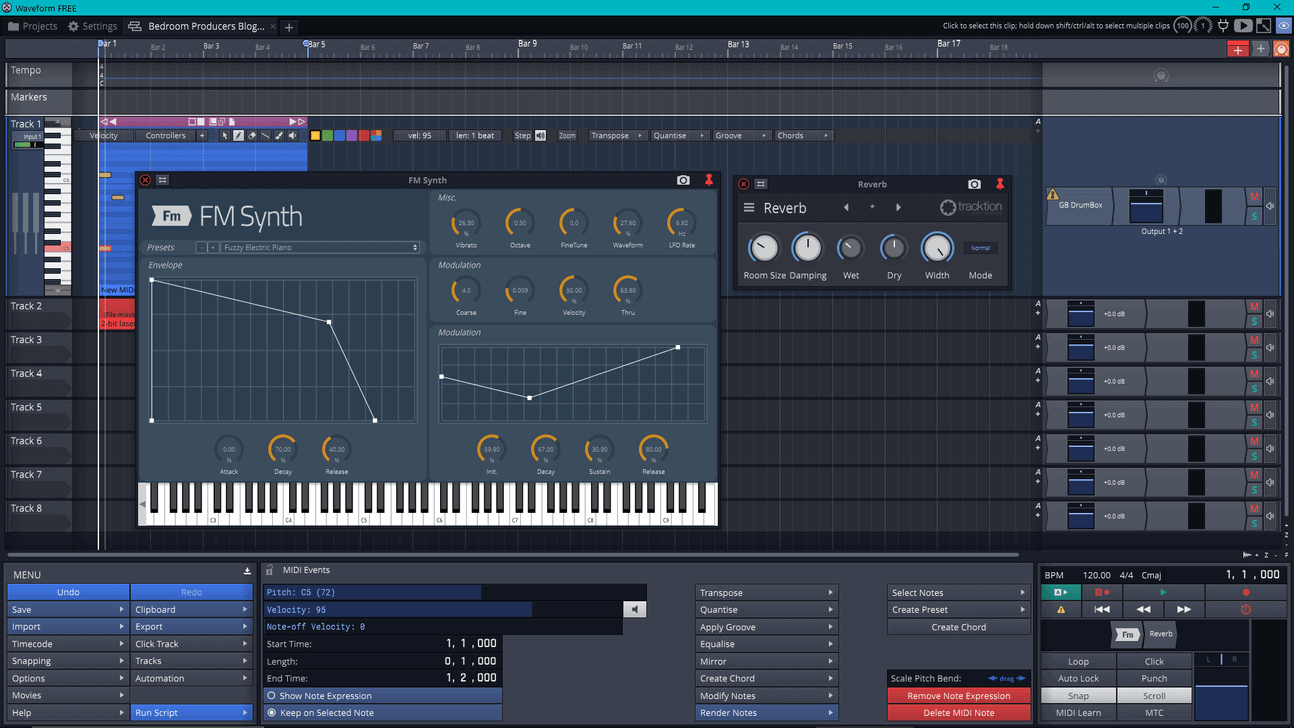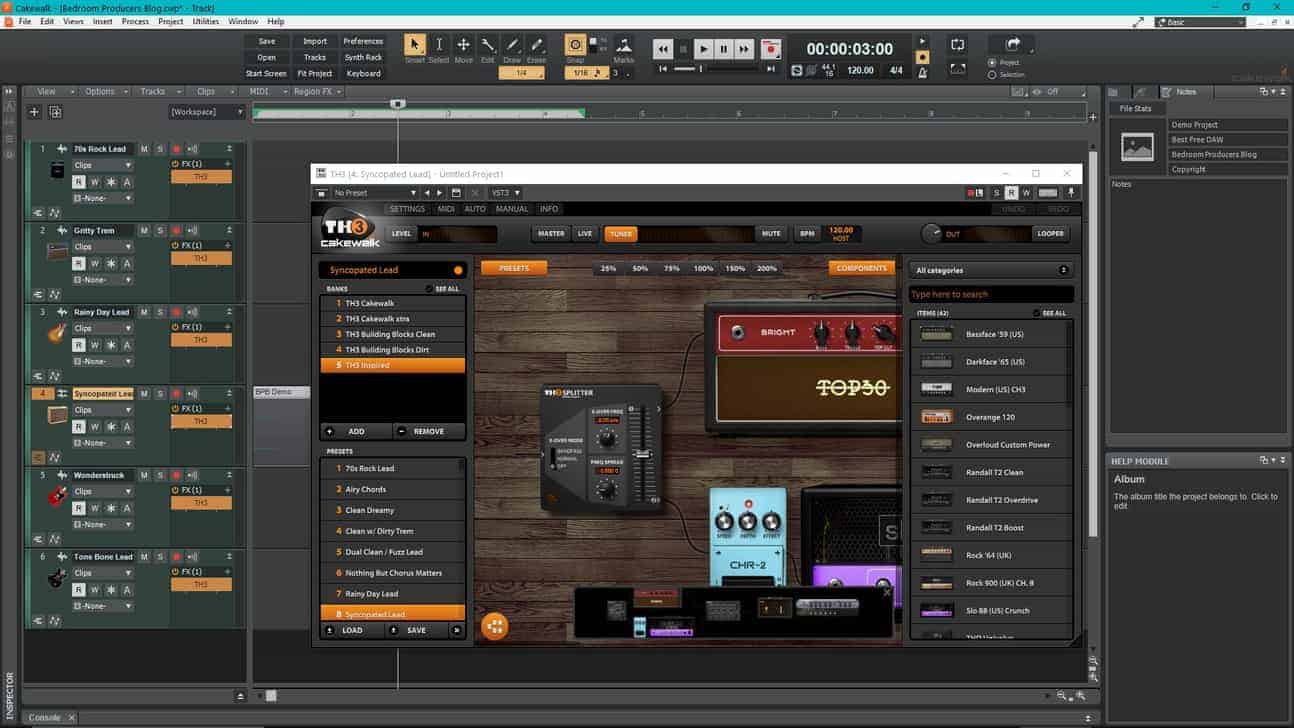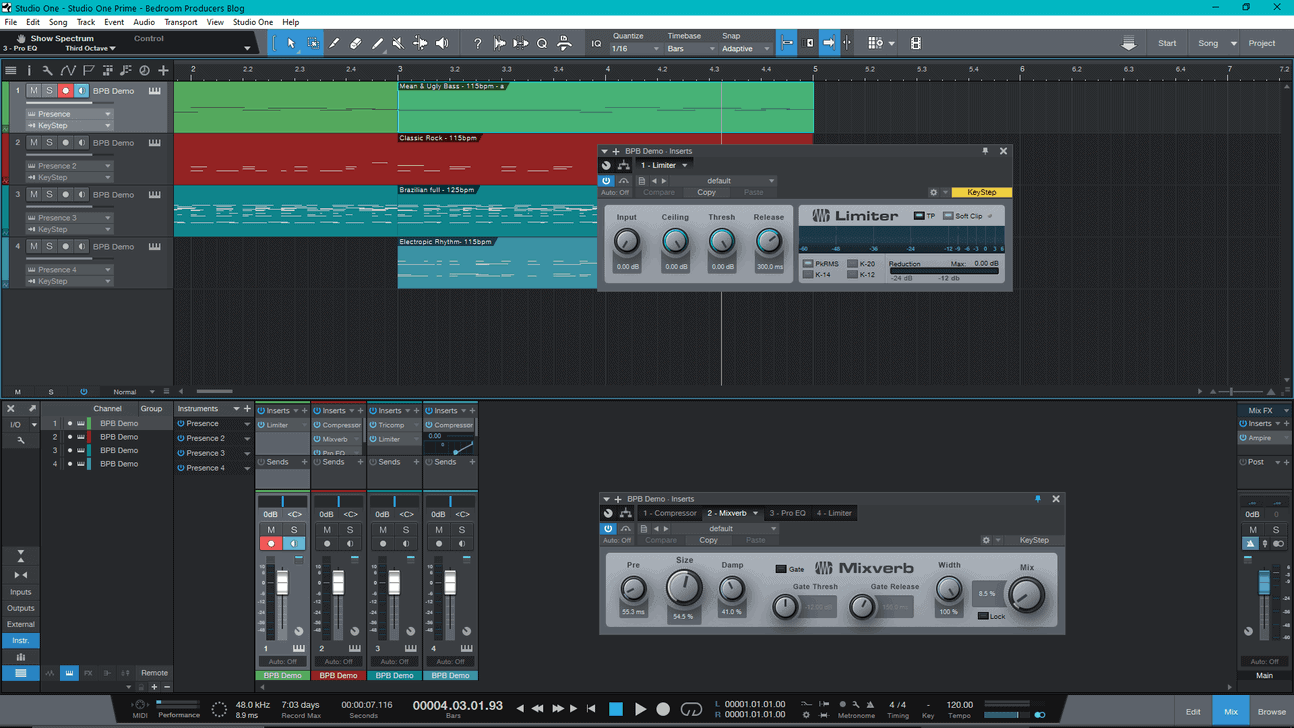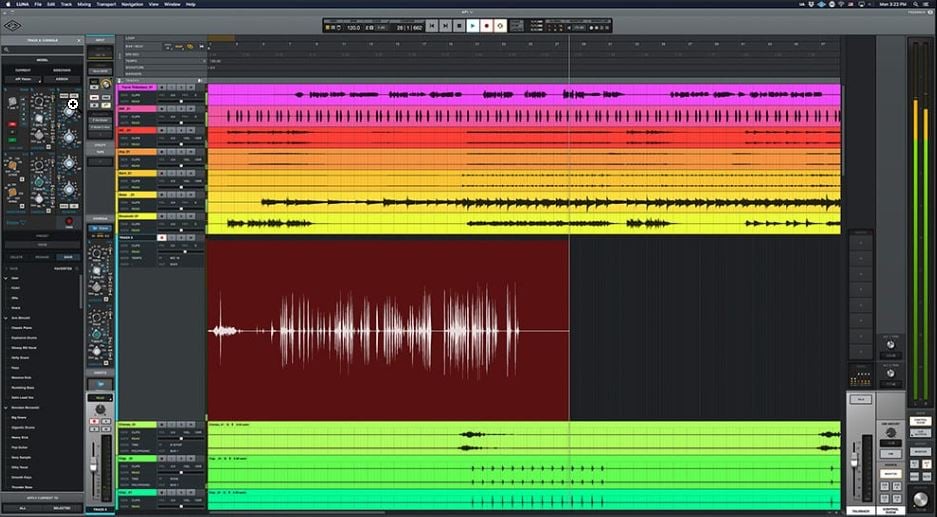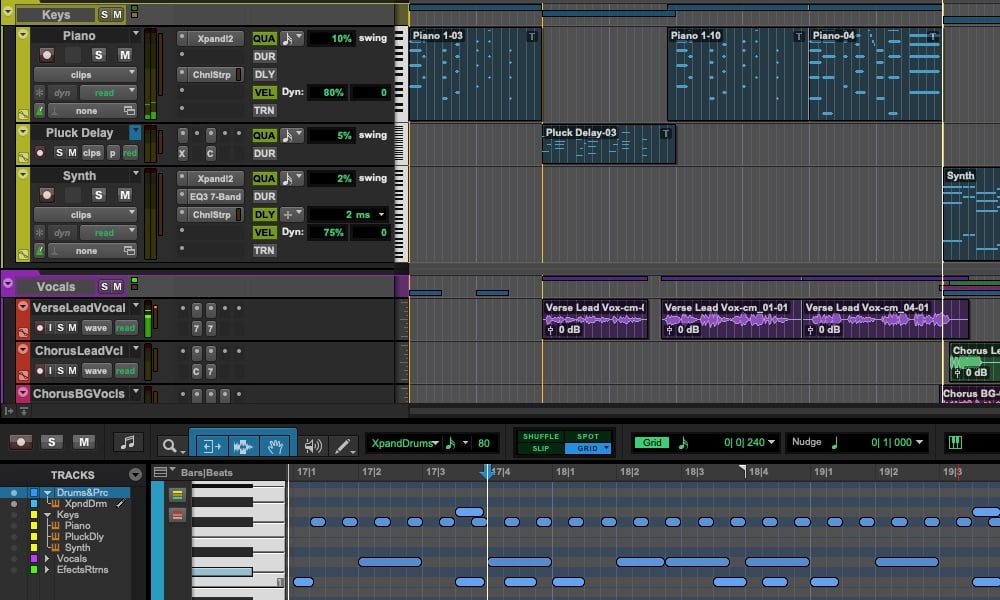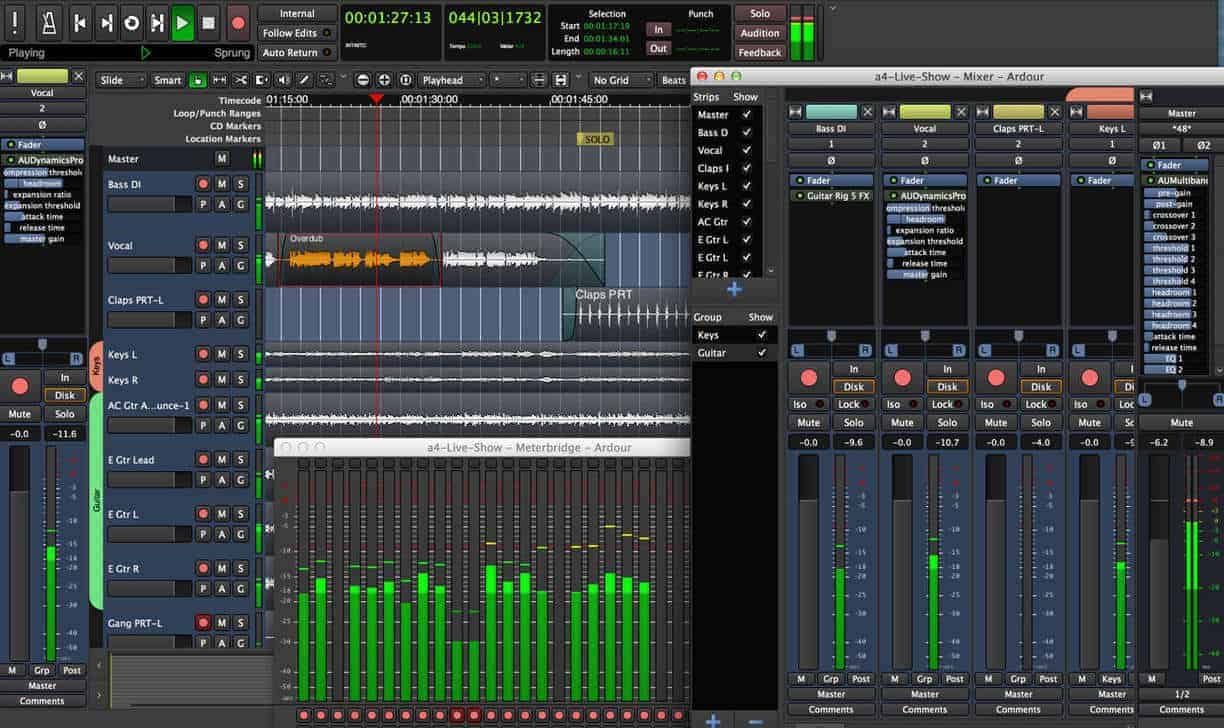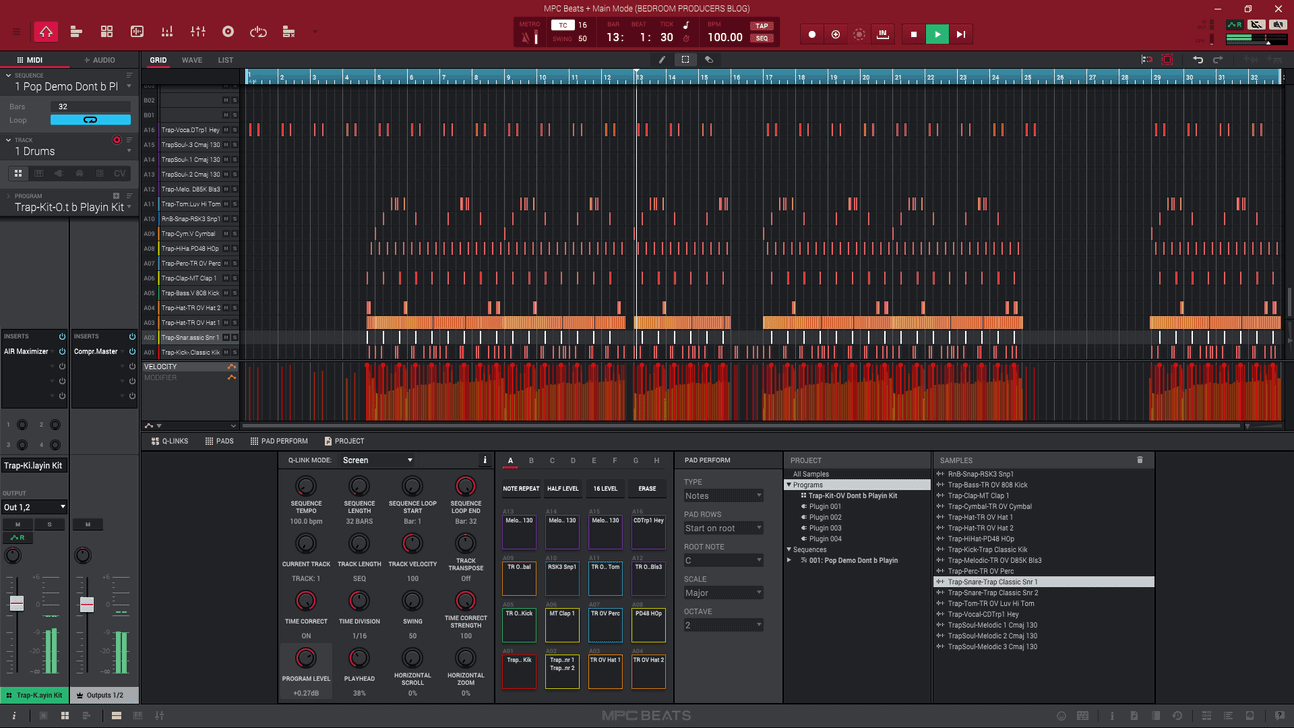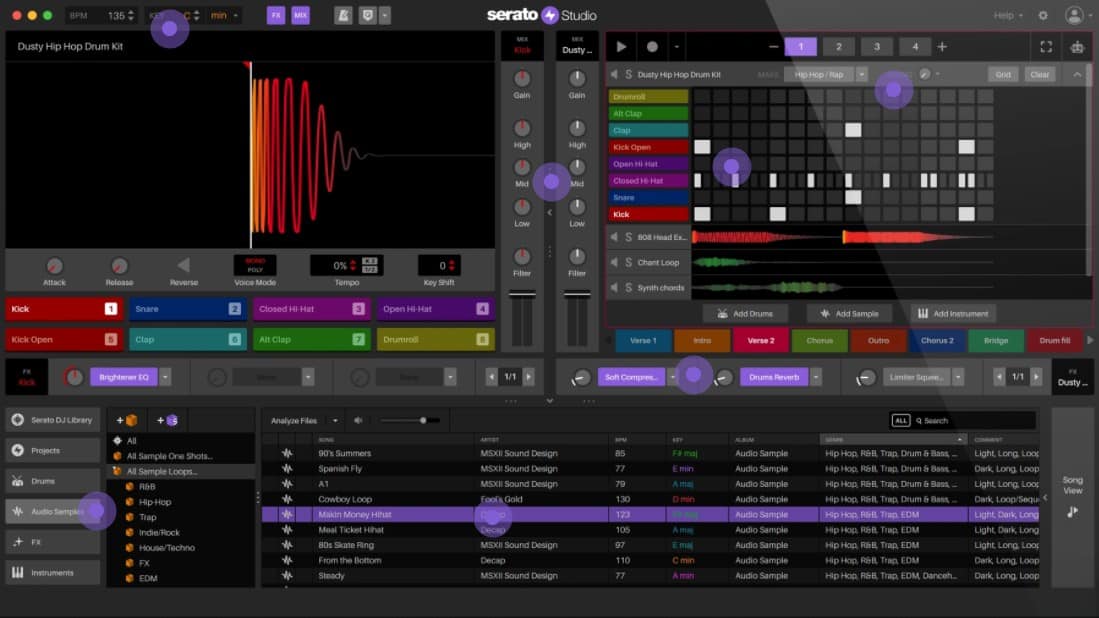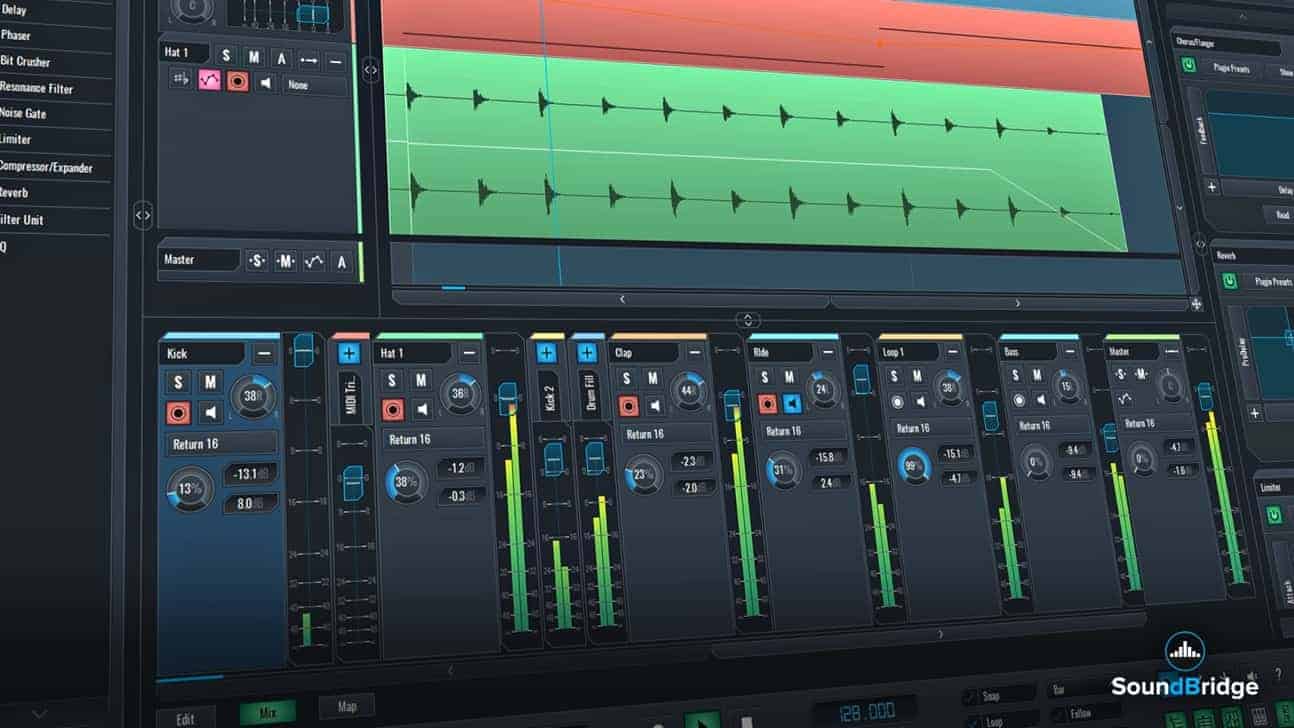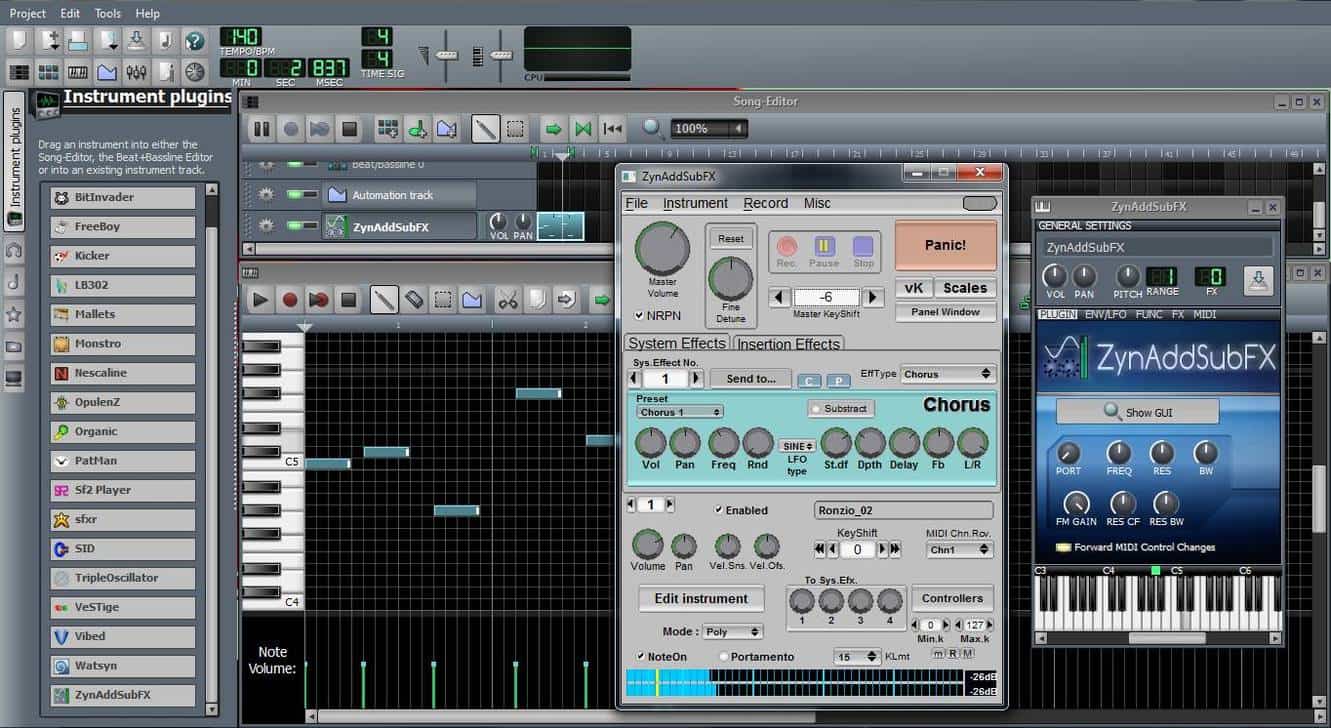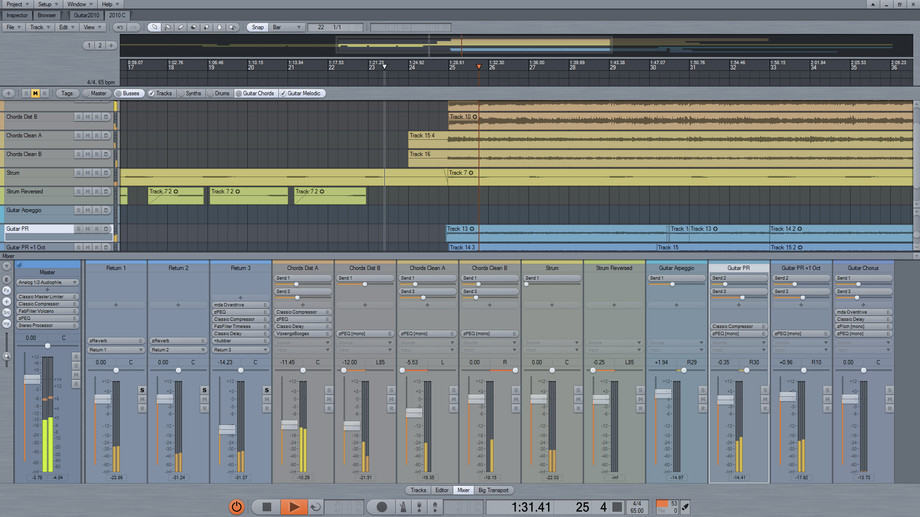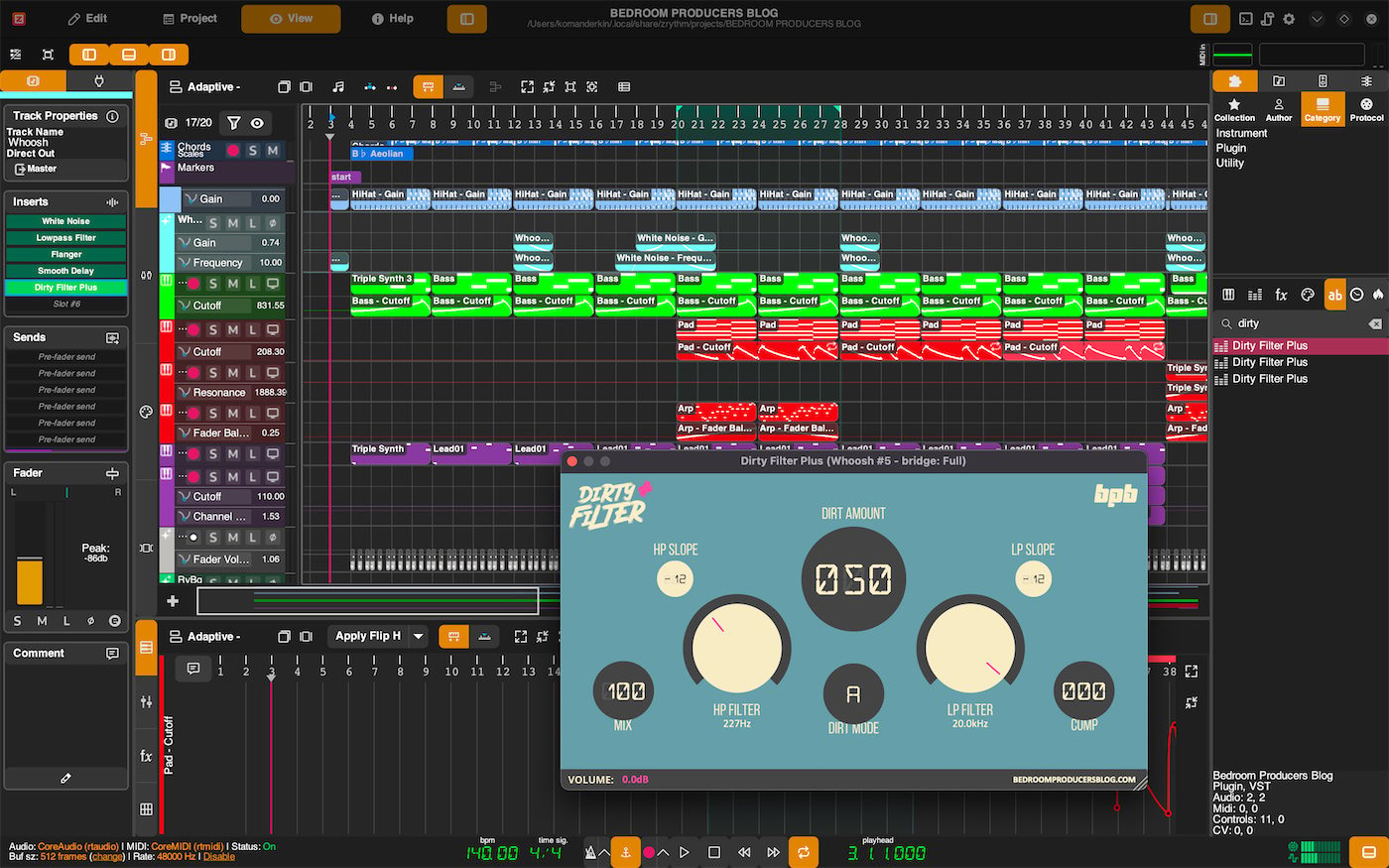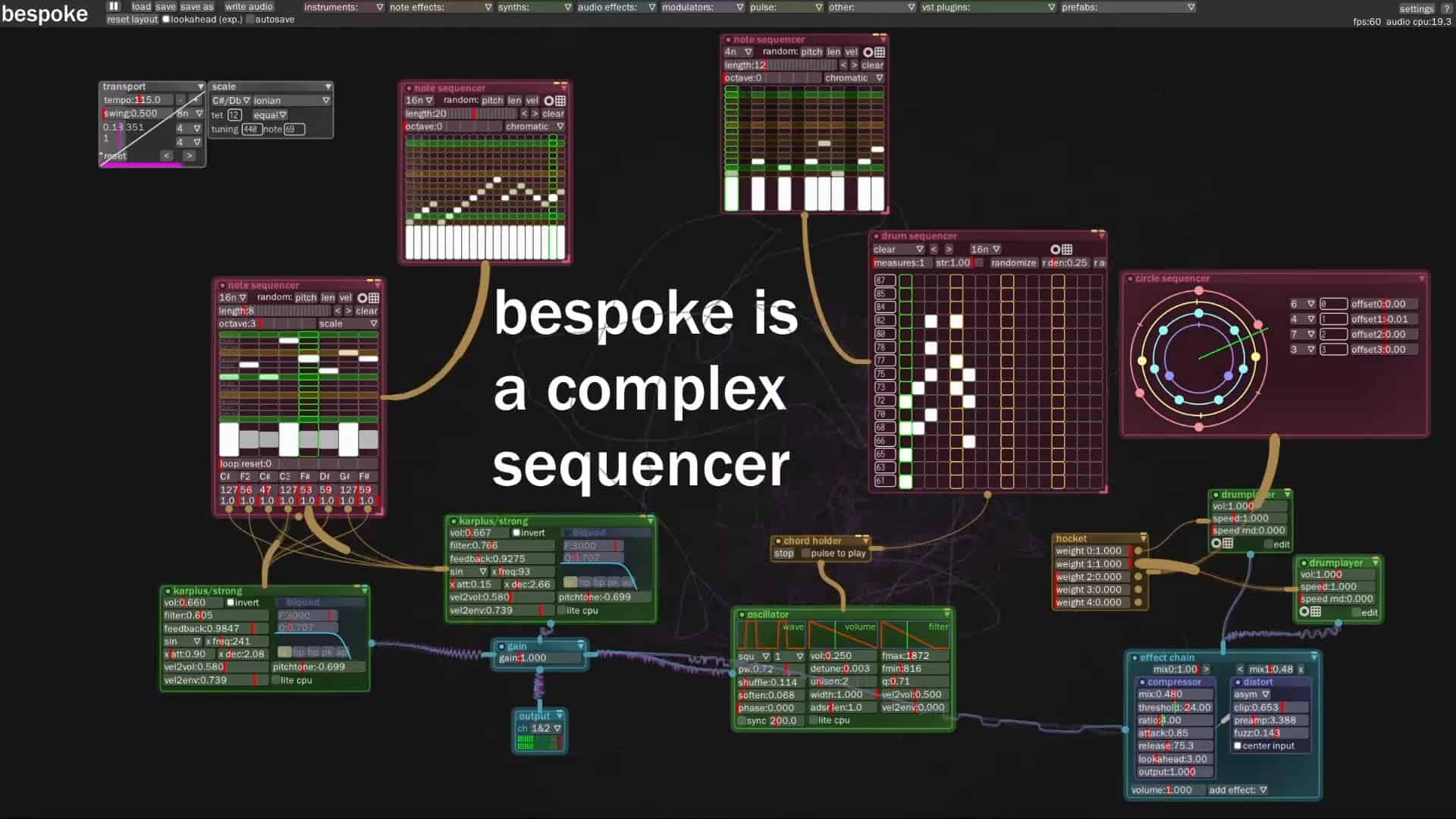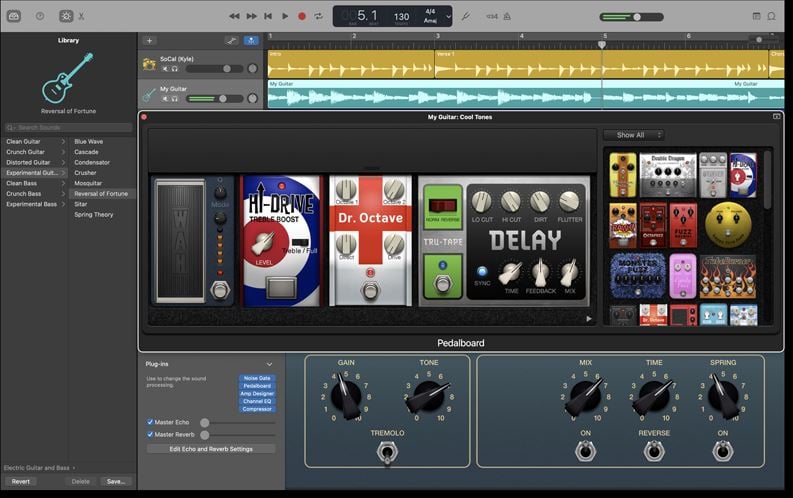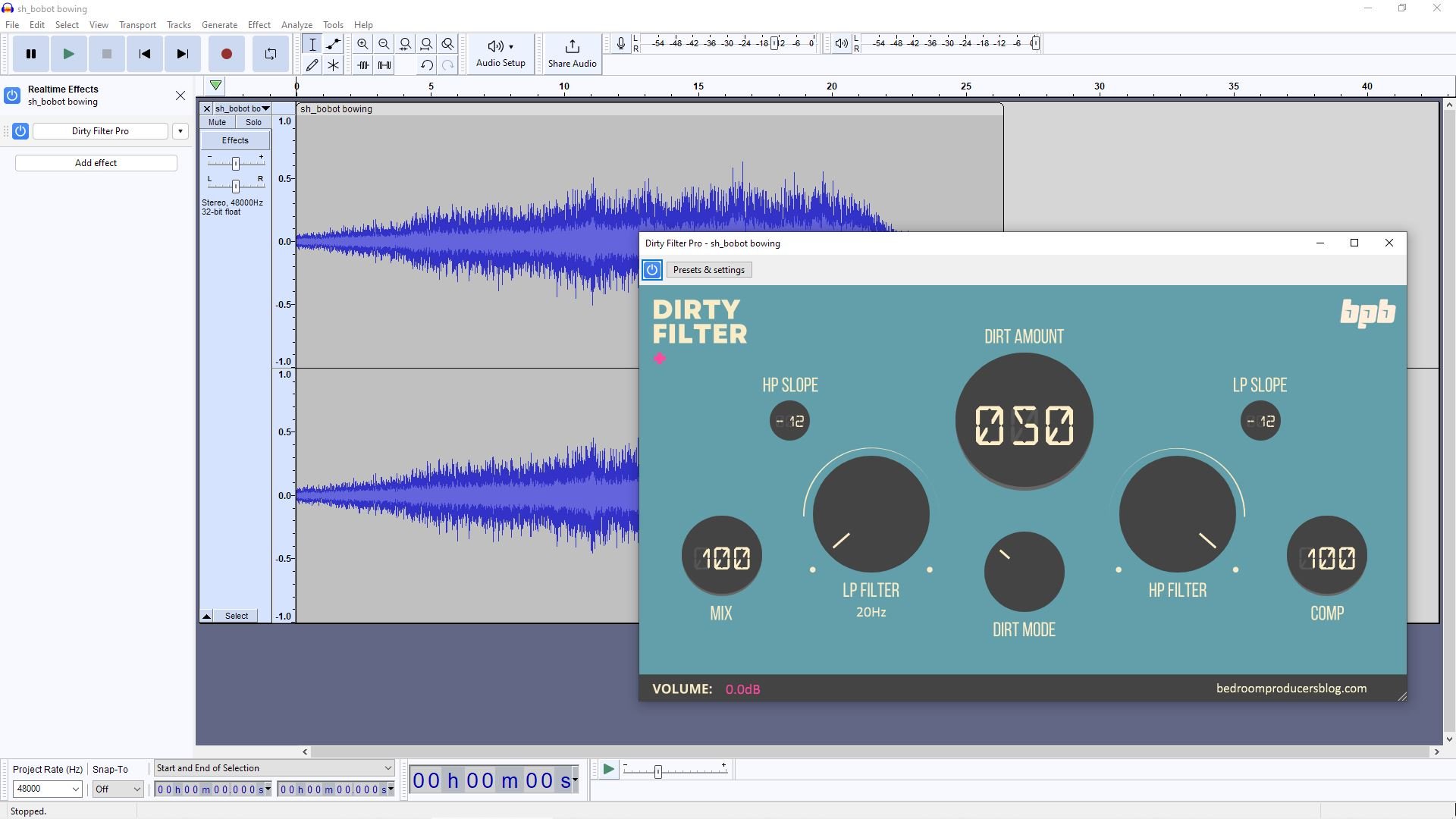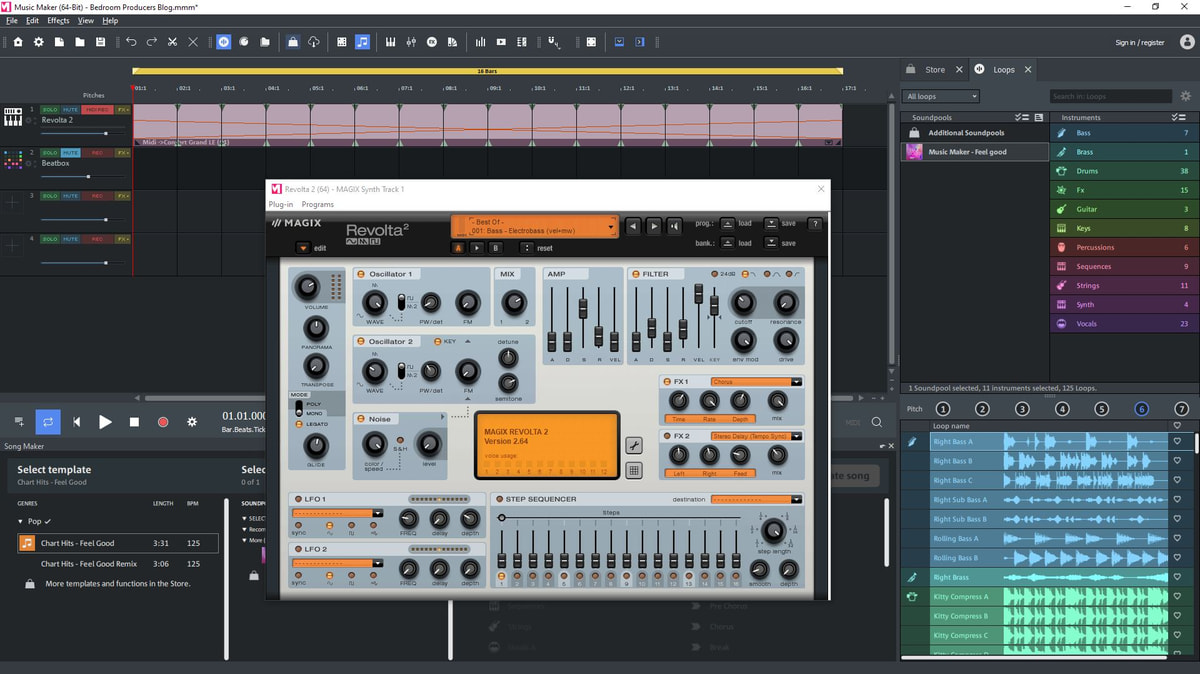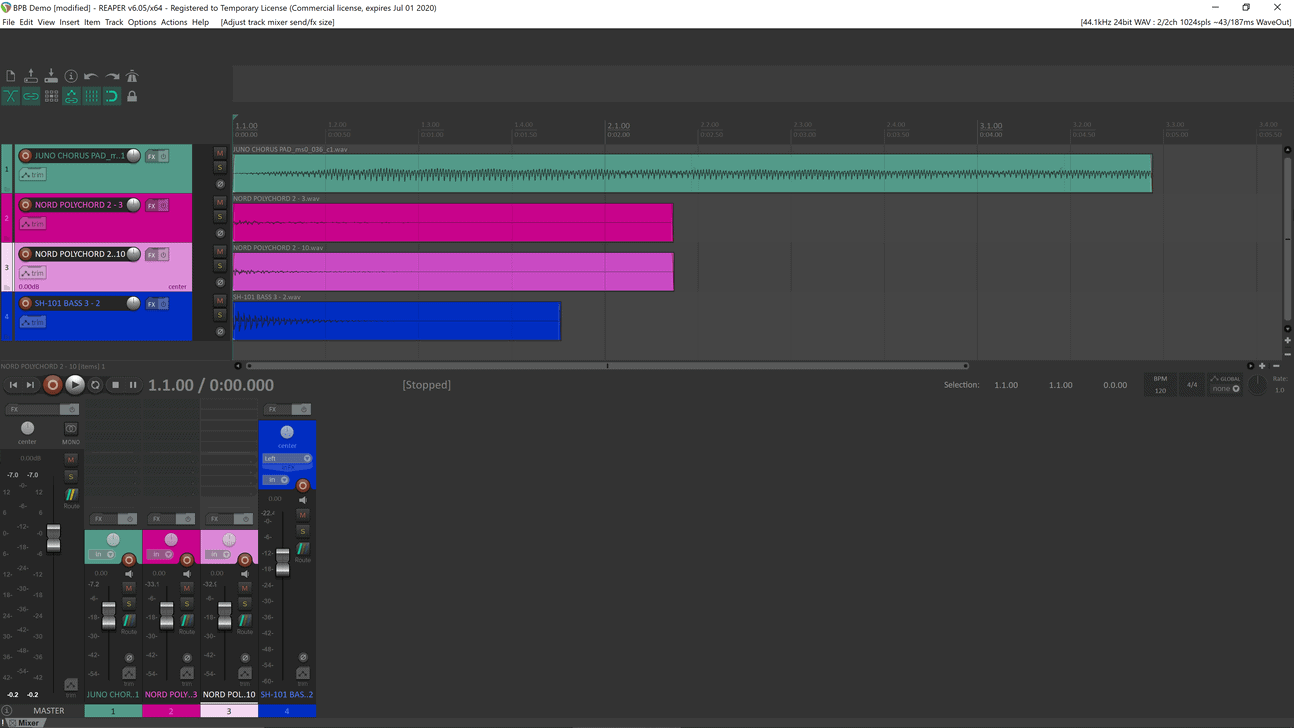Choosing a free DAW for your music studio is like laying your home’s foundation. A digital audio workstation is central to any music production software setup.
Your DAW is where all the audio recording, audio editing, and mixing occur. It’s your mixing console, tape recorder, synth rack, and musical sketchpad.
There are many commercial digital audio workstations on the market. You are probably familiar with Ableton Live, FL Studio, Studio One, Pro Tools, Cubase, Bitwig, and similar premium DAWs.
However, the options are more limited when building a music studio on a tight budget. Only a few high-quality freeware DAWs are available.
Since I started making music in the early 2000s, I have tested countless digital audio workstations (DAWs). Since I enjoy using freeware, I thoroughly test every free DAW while performing my regular music production and sound design work.
The number of freeware digital audio workstations grows yearly, so I wrote this article to help you find the one that suits your music production needs.
The Best Free DAWs (2025 Update)
These are the 19 best free digital audio workstations you can download in 2025:
- Waveform Free
- Cakewalk by BandLab
- Studio One Prime
- LUNA
- Pro Tools – First
- Ardour
- MPC Beats
- Serato Studio
- SoundBridge
- LMMS
- Podium Free
- Zrythm Free
- Bespoke Synth
- GarageBand
- Audacity
- Magix Music Maker
- Reaper (free trial)
- Kristal Audio Engine
- Plugin Buddy
If you need a quick answer, the best options are Waveform Free and Cakewalk by BandLab. Unfortunately, Cakewalk will soon be discontinued.
If you don’t use VST plugins, consider using Studio One Prime by PreSonus. It is ideal for producers who want to record multi-track audio without using virtual instruments or plugins.
However, every producer has different demands, and it is impossible to say which free DAW is the best for everyone. That’s why I thoroughly tested every DAW in this article and listed their pros and cons.
Waveform Free
Pros: VST and ReWire support, fully functional free DAW, low upgrade price.
Cons: Unconventional workflow.
Platforms: Linux, macOS, Windows.
Waveform Free is a feature-packed freeware DAW. It is the free version of Tracktion Corporation’s flagship digital audio workstation software, Waveform Pro.
The software is available across all major operating systems, offering full VST plugin support and ReWire compatibility.
Waveform Free lacks some of the features available in its premium counterpart, but all core functionality is included. Thus, you can use Waveform Free to record, mix, and master your music projects from scratch.
This flexible DAW can even load video files to synchronize your audio project with a movie scene or animation. Tracktion recently updated Waveform Free to further improve the video synchronization workflow.
Waveform Free is the perfect free digital audio workstation for electronic music. It can load virtual instruments and offers all the MIDI features required for sequencing VST plugins.
Waveform Free was designed from the ground up to be intuitive for beginner producers who haven’t previously used a DAW. It comes with an in-depth user manual that explains everything you need to know about music production on a computer.
Tracktion recently released Waveform 13 Free, the latest version of its free DAW. It implements a brand-new audio engine, an improved interface, new audio effects, and several other improvements.
If you want even more features, you must purchase the commercial version of Waveform.
More info: Waveform Free
Cakewalk by BandLab
Pros: SONAR Platinum for free; what more can you ask for?
Cons: Not compatible with macOS. Discontinued.
Platform: Windows (64-bit only).
Cakewalk by BandLab is based on the old SONAR Platinum digital audio workstation (originally priced at $499). BandLab’s free DAW offers the same functionality as its predecessor, minus the bundled third-party software.
Most importantly, Cakewalk is a freeware DAW. The program has all the original SONAR Platinum features, including its native effects (limiters, equalizers, compressors, etc.), analog console-style virtual mixer, VST plugin support, multi-touch support, Bluetooth MIDI, and more.
The free DAW used to require the BandLab Assistant application, but you can now install Cakewalk directly and without any additional software.
It’s also worth noting that there are no nagging ads or other annoyances. The software is fast, reliable, and ready to use on your Windows machine.
Cakewalk by BandLab was developed by some of the leading members of the SONAR developer team. Producers on a tight budget who want the closest thing to a traditional digital audio workstation should choose Cakewalk as their free DAW.
In other words, if you’re looking for a conventional freeware DAW that can load VST plugins, download Cakewalk by BandLab. Unfortunately, BandLab recently announced that the freeware version of Cakewalk will soon be discontinued.
It will be replaced by a new version of SONAR and will no longer be freeware.
More info: Cakewalk by BandLab
Studio One Prime
Pros: Great user interface, external SoundFont support, quality native effects.
Cons: No VST plugin support, only one virtual instrument included.
Platforms: macOS, Windows.
Studio One Prime is a capable free DAW from PreSonus. Its built-in audio effects allow you to record, edit, and mix audio.
Unfortunately, Studio One Prime can’t load third-party VST plugins. That is a potential deal breaker for users who rely on virtual instruments or a specific arsenal of virtual effects in VST plugin format.
On the other hand, Studio One Prime does include a collection of high-quality audio effects developed by PreSonus. It also comes with a 1.5 GB collection of royalty-free sounds and the ability to load third-party SoundFonts.
PreSonus’s free DAW also offers unlimited audio tracks and mixer channels, time stretching, multi-track comping, full MIDI support, advanced automation, and Studio One’s simple side-chain routing workflow.
The lack of VST plugin support is a significant drawback, but Studio One’s native effects are some of the best on the market.
The free version of Studio One includes nine effects, covering all of the essential mixing tools. It includes a three-band equalizer, a compressor, a simple distortion module, a guitar amplifier, reverb, delay, and several modulation effects.
Studio One Prime is the perfect free digital audio workstation for singer-songwriters or bands who want to record and mix their demo sessions.
More info: Studio One Prime
LUNA
Pros: Fast workflow, intuitive interface, excellent effects.
Cons: Requires an iLok user account.
Platforms: macOS, Windows.
Universal Audio made waves in the music production space by offering its LUNA digital audio workstation software for free.
This instantly placed LUNA as a strong contender among free DAWs, and its recently released Windows beta makes it a valid alternative for cross-platform apps like Waveform Free.
LUNA can load third-party plugins, distinguishing it from closed-format DAWs like Studio One Prime and Pro Tools – Intro.
The requirement for a free iLok user account (the dongle is not required) is a potential drawback for producers who don’t like using third-party authentication software. However, the good news is that LUNA doesn’t require you to own any specific UAD hardware.
In short, if you already own a free iLok account, LUNA is one of the best free DAWs you can download now.
LUNA offers enticing features, including an excellent selection of native plugins. My favorite features are its intuitive mixing environment and fast workflow.
I use LUNA as the main DAW on my MacBook Air. Although it’s not my main digital audio workstation in the studio, it’s perfect for carrying around and capturing new ideas when inspiration strikes.
LUNA is an audio recording and mixing tool you can pick up and use immediately. The interface design and the control layout are perfect, whether you’re new to music production or coming from a different DAW.
More info: LUNA
Pro Tools – Intro
Pros: It is built on the same code as the latest Pro Tools.
Cons: Provides only eight audio, instrument, and MIDI tracks.
Platforms: macOS, Windows.
Pro Tools – Intro is the free version of Avid’s industry-leading Pro Tools digital audio workstation. It is built on the same code as the flagship edition of Pro Tools.
Avid’s free DAW is an excellent platform for learning Pro Tools. This is useful if you plan to work in a studio with Pro Tools as the main DAW.
Unfortunately, Pro Tools – Intro is very limited regarding available real estate. It offers only eight audio, instrument, and MIDI tracks.
This is enough for music producers who intend to record only simple songs. Pro Tools – Intro will provide everything you need to get started if you’re a singer/songwriter or a rap artist looking to record vocals over a beat.
On the other hand, if you need more tracks for recording, mixing, and editing your audio, look at the other free DAWs in this article.
More info: Pro Tools – Intro
Ardour
Pros: A fully-fledged open-source DAW for audio recording and production.
Cons: You must build the software yourself (or pay a subscription fee) on Windows and macOS.
Platforms: Linux, macOS, Windows.
Ardour is an open-source digital audio workstation for Linux, macOS, and Windows. It supports all major plugin formats and offers various audio editing and mixing tools.
There is one caveat, though. You cannot simply download and install Ardour on Windows and Mac.
On Linux, downloading the Ardour source code and running the app on your computer is almost seamless.
On Windows and macOS, Ardour is still free, but only if you can compile the provided source code yourself. If not, you have two options: a one-time donation or a subscription.
With a one-time donation, users on macOS and Windows will receive the current version of Ardour and all the minor updates (until the next major version is released).
In contrast, a monthly subscription of $1, $4, or $10 includes significant updates.
More info: Ardour
MPC Beats
Pros: A virtual MPC for free. Also works as a VST plugin in other DAWs.
Cons: Only eight instrument channels.
Platform: Windows (64-bit only).
AKAI entered the DAW market with MPC Beats, a powerful free beat-making software.
Although the app has shortcomings, such as limited audio channels that can be used simultaneously, it offers many features not found in other free DAWs.
For example, MPC Beats can be used as a VST plugin in another digital audio workstation. This means you can run an entire DAW as a plugin in another DAW.
The software also includes over 80 audio effects developed by Air, covering all your mixing and sound design requirements. It also features a high-quality time-stretching algorithm, an advanced step sequencer, and the ability to load third-party plugins in VST and AU formats.
AKAI includes over 2 GB of free sample content with MPC Beats, and users can purchase additional extension packs if needed.
Additionally, MPC Beats features the legendary MPC workflow inherited from AKAI’s hardware products. The software is compatible with various hardware MIDI controllers, including those from AKAI and third-party manufacturers.
If you’re a beatmaker looking for a free DAW, try MPC beats. It’s the closest you’ll get to a hardware MPC-style sampler in software format.
More info: MPC Beats
Serato Studio
Pros: A free DAW designed for beatmakers. Great workflow if you’re working with samples and loops.
Cons: If you’re coming for a more traditional DAW, the workflow will take some time to get used to.
Platforms: macOS, Windows (64-bit).
Serato Studio is a relatively new free DAW that doesn’t try to copy its predecessors.
Instead, the developers at Serato created a music-making tool with a unique workflow to suit both experienced producers and absolute beginners.
Beatmakers who use samples and loops will benefit the most from Serato Studio’s innovative workflow. The program has a step sequencer, an intuitive sampler, and plenty of tools for manipulating, time-stretching, and slicing audio loops and samples.
You can import sounds, record audio, add automation, use virtual instruments and effects, etc.
Despite its unconventional layout, the interface is intuitive. Even if you’re a beginner, you can easily pick up Serato Studio and build a beat from scratch.
The drawback is that producers who are used to more traditional DAW platforms like Cubase or Ableton will need some time to adjust to Serato Studio’s unique workflow.
More info: Serato Studio
SoundBridge
Pros: VST plugin support, virtual drum machine included, multi-touch support.
Cons: Lacks some of the advanced features found in other DAWs.
Platforms: macOS, Windows.
SoundBridge is a simple online DAW with a streamlined user interface. It is an excellent choice for beginners and less demanding users.
It doesn’t have all the bells and whistles found in more advanced DAWs like Waveform Free and Cakewalk by BandLab. On the other hand, there’s plenty of functionality for users just starting to make music on a computer.
Most importantly, SoundBridge can load third-party VST plugins. Users who program drum beats from scratch will love that SoundBridge includes an MPC-style drum sampler/sequencer and a collection of essential mixing and mastering effects.
Furthermore, this free DAW is optimized for the Universal Windows Platform (UWP), has hand gestures implemented, and can scale the interface.
More info: SoundBridge
LMMS
Pros: VST plugin support, ZynAddSubFX, open-source.
Cons: There are some stability issues, a relatively steep learning curve, and no audio recording.
Platforms: Linux, macOS, Windows.
LMMS (short for Linux Multimedia Studio) is an open-source pattern-based DAW built by a team of volunteers.
Its design and workflow are inspired by a commercial product – the well-known FL Studio (formerly Fruity Loops) digital audio workstation by Image-Line.
FL Studio’s pattern-based workflow is nicely implemented in LMMS. However, the interface still lacks polish, making the user experience underwhelming.
The graphical elements are not very intuitively designed, and new users will probably need some time to get familiar with the application and its features.
LMMS is packed with built-in effects and virtual instruments, including the ZynAddSubFX synthesizer, one of the most versatile freeware instruments. This freeware DAW can also host VST plugins and connect to other applications via the JACK Audio Server.
The built-in beat/bassline editor is great, and the piano roll works well to create and edit more complex MIDI sequences. Sadly, LMMS can’t record audio, so the only workaround is generating sounds using virtual instruments or imported samples.
Even so, LMMS is a decent free DAW for electronic music producers, beatmakers, and anyone who creates music exclusively using virtual instruments and samples.
More info: LMMS
Podium Free
Pros: VST plugin support, intuitive user interface, fast workflow.
Cons: Single core processing for VST plugins, no ReWire support, not cross-platform compatible.
Platform: Windows.
Podium Free is our long-time favorite. It is a powerful, free digital audio workstation that combines a modern user interface with a fast workflow.
The DAW was built with electronic musicians in mind, focusing on virtual instruments as the primary sound source. However, it can also be used to record and mix real instruments.
The free version of Podium offers decent VST plugin support (not limited to a certain number of plugins per project) and a robust object-based project structure with a virtual mixer. It also has powerful audio recording and editing tools, track freeze/bounce, and external MIDI controller support.
The main limitation of Podium Free is that the DAW doesn’t support multi-core CPUs. If you use a quad-core processor, only one of the four CPU cores will be used to process plugins.
You’ll need to monitor the CPU performance indicator closely and use less demanding plugins in your projects. Track freezing and bouncing can also help to reduce the overall CPU load.
More info: Podium Free
Zrythm Free
Zrythm is an open-source digital audio workstation for Windows, macOS, and Linux. The free version lets you use up to 25 audio tracks.
The DAW has all the features of a modern audio workstation. It can load all major plugin formats and offers an advanced MIDI sequencing workflow. It also features full parameter automation and a robust suite of audio effects.
It also offers some features you won’t find in most other DAWs. For example, Zrythm can load SoundFonts as virtual instruments, letting you customize some of the app’s parameters.
However, the software is still in beta and isn’t fully polished. I tested it on an M1 Macbook Air and experienced some stability issues.
Still, Zrythm shows plenty of potential, and it’s on the right course to become one of the best free digital audio workstations.
More: Zrythm
Bespoke Synth
Pros: Virtually limitless patching and modular experimentation capabilities.
Cons: The modular workflow is probably too complicated if you’re looking for a simple free DAW.
Platforms: Linux, macOS, Windows.
The developer describes Bespoke Synth as “a customizable playground for sound.” He also says the software is “a bit like smashing Ableton Live to bits with a baseball bat and then putting it back together.”
Fans of modular synthesizers will feel right at home with Bespoke Synth. It is ideal if you enjoy connecting synth modules, creating patches from scratch, and imagining your perfect DAW from the ground up.
Otherwise, you’ll find this particular free DAW too complicated to use.
However, if you enjoy virtual modular software like VCV Rack, I highly recommend trying Bespoke Synth.
More info: Bespoke Synth
GarageBand
GarageBand is the first free DAW used by many music producers. It is included with all Mac computers and designed to be intuitive and easy to use.
Unsurprisingly, Apple’s freeware DAW has a decent collection of virtual instruments and sounds. But, users who want a more advanced digital audio workstation should look elsewhere.
GarageBand is enough to start making music if you’re a beginner music producer with a macOS machine.
More info: GarageBand
Audacity
Audacity is a free audio editor that can also work as a DAW. If you need to edit audio files or create simple songs, Audacity can substitute a real digital audio workstation.
Recent updates added some useful DAW-like features to Audacity. It can load VST plugins (only effects) and process them in real time. This means you can preview and adjust the audio effects before applying them to the audio file.
Audacity still lacks primary DAW features like a multi-channel mixer and virtual instrument support, but it can work as a bare-bone tool for making music on a computer.
More info: GarageBand
Magix Music Maker
Music Maker by Magix is a free DAW for absolute beginners. In terms of its features and functionality, it is an equivalent of GarageBand on Windows.
It comes with a small selection of virtual instruments and effects packed in a streamlined user interface that is easy to learn. The software is a good starting point for musicians who want to learn to produce music on a computer, but nothing more.
Look at the other freeware DAWs featured in the article for advanced functionality.
More info: Music Maker
Reaper
REAPER is NOT free to use, but it is free to try. Many users believe that Reaper is free, but that is only true about the trial version.
The asking price of $60 for a discounted license is more than fair, considering the program’s flexibility and continuous updates with new features and improvements.
REAPER is an incredibly powerful and versatile digital audio workstation that supports all major plugin formats. It has a vast collection of high-quality effects for processing audio and MIDI data, powerful audio and MIDI routing capabilities, and a very active user community.
More info: REAPER
KRISTAL Audio Engine
KRISTAL Audio Engine is a discontinued digital audio workstation that works well on older operating systems.
The program was developed by KristalLabs, a team of programmers that later worked on creating Studio One.
Unlike Studio One Prime, KRISTAL Audio Engine can load up to two VST plugins per channel and three on the master bus.
Plugin Buddy
If you only need a simple app to load VST3 plugins, look at Plugin Buddy by Modalics.
It is a simple VST3 host that can load plugins and let you play them, save presets, and apply built-in effects. However, you can also use Plugin Buddy inside your chosen DAW to expand its capabilities.
It saves custom effects chains in your main digital audio workstation, providing quick access to your favorite tools.
So, Plugin Buddy is a great option if you’re looking for a free DAW power-up.
I use it to save and quickly load my favorite settings for mixing, mastering, and sound design. Simply add an instance of Plugin Buddy to a channel, load your favorite plugins, adjust the settings, and save them as a preset. The next time you’re working on a project in your DAW, load the preset, and you’re good to go!
Choosing A Free DAW
If you’re an electronic music producer, Waveform Free is probably the best free digital audio workstation for you. It can load VST plugins, comes with its own virtual instruments, and offers a range of tools for electronic music production.
Singers/songwriters will probably enjoy Studio One Prime the most. This free DAW can’t load plugins, but its workflow and included audio effects are perfect for capturing your performances.
Beatmakers should look into alternative DAWs like LMMS and SoundBridge. However, beginners will probably enjoy SoundBridge’s streamlined workflow and design. LMMS, on the other hand, is heavily inspired by FL Studio and its beatmaking workflow.
Rock and metal producers can try Cakewalk. It’s excellent for recording and mixing audio. More importantly, it can load VST plugins, so you can use your favorite virtual guitar amps and effects.
For more freeware plugins and instruments, return to our Free VST Plugins page.
Last Updated on January 9, 2025 by Tomislav Zlatic.








